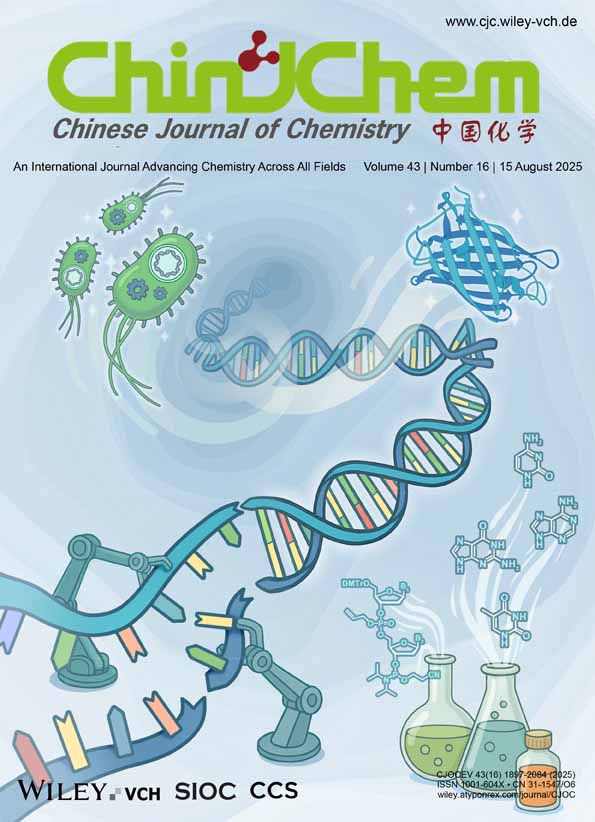Bright red electroluminescent devices based on a soluble lanthanide complex Eu(DBM)3(phen)
Ma Dong-Ge
Changchun Institute of Applied Chemistry, Chinese Academy of Sciences, Changchun, Jilin 130022, China
Search for more papers by this authorWang Dai-Ke
Changchun Institute of Applied Chemistry, Chinese Academy of Sciences, Changchun, Jilin 130022, China
Search for more papers by this authorHong Zhi-Yong
Changchun Institute of Applied Chemistry, Chinese Academy of Sciences, Changchun, Jilin 130022, China
Search for more papers by this authorZhao Xiao-Jiang
Changchun Institute of Applied Chemistry, Chinese Academy of Sciences, Changchun, Jilin 130022, China
Search for more papers by this authorJing Xia-Bin
Changchun Institute of Applied Chemistry, Chinese Academy of Sciences, Changchun, Jilin 130022, China
Search for more papers by this authorWang Fo-Song
Changchun Institute of Applied Chemistry, Chinese Academy of Sciences, Changchun, Jilin 130022, China
Search for more papers by this authorLi Bin
Laboratory of Rare Earth Chemistry and Physics, Changchun Institute of Applied Chemistry, Chinese Academy of Sciences, Changchun, Jilin 130022, China
Search for more papers by this authorZhang Hong-Jie
Laboratory of Rare Earth Chemistry and Physics, Changchun Institute of Applied Chemistry, Chinese Academy of Sciences, Changchun, Jilin 130022, China
Search for more papers by this authorWang Shu-Bin
Laboratory of Rare Earth Chemistry and Physics, Changchun Institute of Applied Chemistry, Chinese Academy of Sciences, Changchun, Jilin 130022, China
Search for more papers by this authorMa Dong-Ge
Changchun Institute of Applied Chemistry, Chinese Academy of Sciences, Changchun, Jilin 130022, China
Search for more papers by this authorWang Dai-Ke
Changchun Institute of Applied Chemistry, Chinese Academy of Sciences, Changchun, Jilin 130022, China
Search for more papers by this authorHong Zhi-Yong
Changchun Institute of Applied Chemistry, Chinese Academy of Sciences, Changchun, Jilin 130022, China
Search for more papers by this authorZhao Xiao-Jiang
Changchun Institute of Applied Chemistry, Chinese Academy of Sciences, Changchun, Jilin 130022, China
Search for more papers by this authorJing Xia-Bin
Changchun Institute of Applied Chemistry, Chinese Academy of Sciences, Changchun, Jilin 130022, China
Search for more papers by this authorWang Fo-Song
Changchun Institute of Applied Chemistry, Chinese Academy of Sciences, Changchun, Jilin 130022, China
Search for more papers by this authorLi Bin
Laboratory of Rare Earth Chemistry and Physics, Changchun Institute of Applied Chemistry, Chinese Academy of Sciences, Changchun, Jilin 130022, China
Search for more papers by this authorZhang Hong-Jie
Laboratory of Rare Earth Chemistry and Physics, Changchun Institute of Applied Chemistry, Chinese Academy of Sciences, Changchun, Jilin 130022, China
Search for more papers by this authorWang Shu-Bin
Laboratory of Rare Earth Chemistry and Physics, Changchun Institute of Applied Chemistry, Chinese Academy of Sciences, Changchun, Jilin 130022, China
Search for more papers by this authorAbstract
Electroluminescent devices with PVK film doped with Eu(DBM)3(phen) and PBD were fabricated. The device structure of glass substrate/indium-tin-oxide/PPV/PVK:Eu(DBM)3(phen):PBD/Alq3/Al was employed. The emissive layer was formed by spin-casting method. A sharply red electroluminescence with a maximum luminance of 114.4 cd/m2 was achieved at 42 V.
References
- 1 Tand, C. W.; Vanslyke, S. A., Appl. Phys. Lett., 51, 913 (1987).
- 2 Tand, C. W.; Vanslyke, S. A.; Chen, C. H., J. Appl. Phys., 66, 3610 (1989).
- 3 Adachi, C.; Tokito, S.; Tsutsui, T.; Saito, S., Jpn. J. Appl. Phys., 27, L269 (1988).
- 4 Kido, J.; Ohtaki, C.; Hongawa, K.; Okuyama, K.; Nagai, K., Jpn. J. Appl. Phys., 52, L917 (1993).
- 5 Hosokawa, C.; Higashi, H.; Nakamura, H.; Kusumoto, T., Appl. Phys. Lett., 67, 3853 (1995).
- 6
Burrough-, J. H.;
Bradley, D. D. C.;
Brown, A. R.;
Marks, R. N.;
Mackay, K.;
Friend, R. H.;
Burns, P. L.;
Holmes, A. B.,
Nature,
347,
539
(1990).
10.1038/347539a0 Google Scholar
- 7 Grem, G.; Leditsky, G.; Ullrich, B.; Leising, G., Adv. Mater., 4, 36 (1992).
- 8 Greenham, N. C.; Moratti, S. C.; Bradley, D. D. C.; Friend, R. H.; Holmes, A. B., Nature, 365, 628 (1993).
- 9 Yang, Z.; Sokolik, I.; Karass, F. E., Macromolecules, 26, 1188 (1993).
- 10 Bradley, D. D. C., Sylth. Metal, 55–57, 431 (1993).
- 11 Kido, J.; Nagai, K.; Ohashi, Y., Chem. Lett., 657 (1990).
- 12 Kido, J.; Nagai, K.; Okamoto, Y.; Skotheim, T., Chem. Lett., 1267 (1991).
- 13 Kido, J.; Hayase, H.; Hongawa, K.; Nagai, K.; Okuyama, K., Appl. Phys. Lett., 66, 2124 (1994).
- 14 Melby, L. R.; Rose, N. J.; Abramson, E.; Caris, J. C., J. Am. Chem. Soc., 86, 5117 (1964).
- 15 Wan, R. E.; Crosby, G. A., J. Mol. Spectrosc., 8, 315 (1962).




